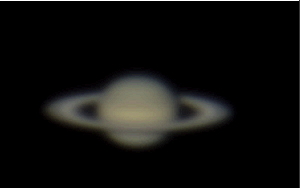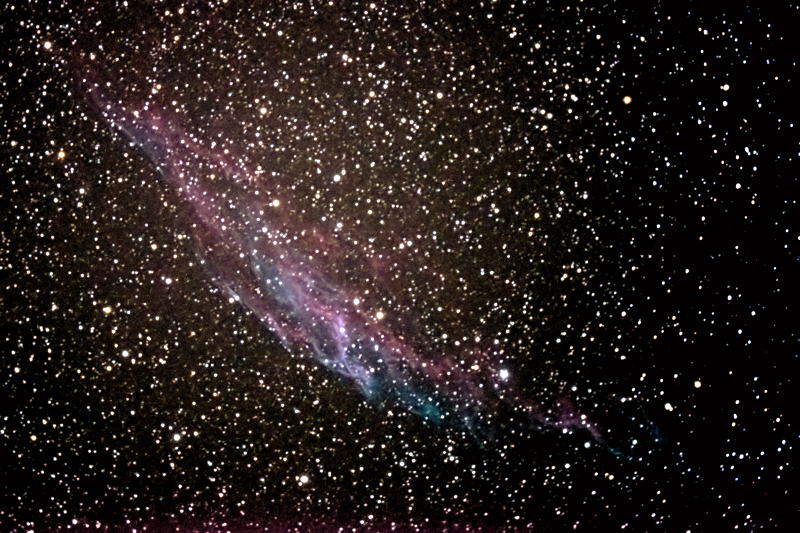
D7000 Imaging: Mercury, Saturn, IC5067, NGC6992
Posted: 20 June 2012
Opened the observatory Tuesday, 19 June, at 1905 MST, 97°F. The sky was clear and less hazy than on the previous night. At 1913 MST, viewed Mercury, 77X and 206X. I then set up for eyepiece projection (160X) imaging with the D7000 DSLR. I had a lot of difficulty getting Mercury into the small FOV of the 12.5mm eyepiece and then focusing it. Seeing was not very good and Mercury got lower in the sky the longer it took. Finally at 1938 MST, I was able to begin HD video recording, 1/60sec, ISO 1600. Unfortunately, none of the frames were good enough for stacking due to the poor seeing. However, I did find one frame that was fairly representative of Mercury:

At 1946 MST, slewed to Saturn and viewed it at 77X. At 2012 MST, I saw the first of four Kissing Bugs for the night. I set up for eyepiece projection (160X) imaging of Saturn. Did a focus test on Spica using the Bahtinov Mask. I then did 5 minute, HD video recordings, 1/30sec, ISO 3200. This is a stack of 6782 frames from one of the videos:

Ended Saturn imaging at 2036 MST. Began observing Saturn, 133X. Seeing was not very good; I could barely see Cassini Division at any magnification (which is why the image above is so poor). I could see the moons Titan, Dione, Tethys, and Rhea. I tried for Enceladus but it was too close to the Ring.
At 2118 MST, I started a tour of DSOs in the constellation of Ophiuchus, 77X: M107, M12, M10, M62, M19, M9, M14 (all globular clusters), and NGC6633 (open cluster). I then viewed Alpha Hercules, a nice double star.
At 2149 MST, I SYNCed on Deneb and slewed to IC5067 (Pelican Nebula). I then began waiting for it to rise higher in the sky. Unlike the previous night with its very hazy sky, the Milky Way was clearly seen this night. I began imaging preps at 2233 MST. Did a focus test on Deneb with the Bahtinov Mask and then did a framing test exposure on IC5067. I had a good guide star but no nebula was visible in the 1 minute, ISO 6400, exposure. I decided to try a guided 5 minute exposure anyway. This resulted in capturing a portion of the nebula. I added the focal reducer. Did another focus test on Deneb and another framing test exposure. Got a faint guide star. This is a guided 5 minute, ISO 6400, exposure:

I then slewed to NGC6992, a diffuse nebula. Did a framing test exposure; found a faint guide star. This is a 5 minute, ISO 6400, guided exposure, slightly cropped from the full-frame image:

Ended imaging at 2340 MST.
Closed the observatory at 0000 MST, 73°F. Terminated three Kissing Bugs during the night. A fourth one got away.
I have uploaded a corrected version of the Pluto animated images from 15 June and 17 June 2012. This version does not stop after a few cycles. Click the link to see the new version and watch Pluto move.
Comments are welcome; use the Comments section below, or you can Email Me. Thanks.
Go to the previous report.
Return to the Cassiopeia Observatory Welcome Page.